March 4, 2019, by Benjamin Thorpe
“Spaces of Internationalism”: Making an Exhibition of Ourselves
Complementing and coinciding with our recent conference at the Royal Geographical Society (with the Institute of British Geographers, hereafter simply ‘RGS’), the same venue played host to our exhibition, titled ‘Spaces of Internationalism’. We launched the exhibition on the day before the conference, Monday 17th December 2018, and it ran until 22nd January 2019, with a break over the RGS’s Christmas closure period from 22nd December to 1st January. While the exhibition panels are now safely packed away in storage, it lives on in digital form as a virtual exhibition free for all to access online. The process of putting together the exhibition – in both its real and virtual forms – was a new adventure for many of us, and in addition to representing a significant output of our research, was an experience from which we learnt a lot.
Design
The exhibition was long in the planning, having been written into the project grant as one of the anticipated major outputs. With this in mind, each of the team had been collecting various bits of visual material throughout their project research, highlights of which included the photography of Erich Salomon, the rich photographic archive of the Mundaneum in Belgium, the League of Nations’ photo archive and the elaborate invitations sent to the Maharaja of Bikaner during his stay in London for the Round Table Conference. The plan was to showcase this visual material in an exhibition on interwar internationalism.
Nevertheless, when it came to assembling these images into 24 panels that could tell a story about internationalism, it soon became clear that plenty of work remained ahead of us. Rather than arrange our images according to the various ‘types’ of internationalism they portrayed (liberal, imperial, radical, etc), we wanted to be able to tell a story about the spaces themselves, whether they be conference venues, the transportation that delegates used, the institutions that organised internationalist events, or the imaginations of globality they promoted. Our solution was to use a basic structure that divided the panels in half: twelve ‘front-facing’ panels that would each address a particular spatiality of internationalism, arranged in descending order according to their scale. On the opposing sides of these panels, another twelve that would tell the ‘behind-the-scenes’ stories of those figures who were often overlooked by orthodox accounts of internationalism.
The next stage was to settle on the topics and images for each panel, balancing the demands of this organisational logic with the stock of striking images that we wanted to use, and the stories that we wanted to include. Approaching our material from this new angle, and bringing together the various strands that the team had each been working on, proved a creative endeavour in its own right. On a more practical note, two major tasks remained: to find images where we did not already have them, and in all cases to seek copyright status (and if necessary, clearance) and high resolution versions to use. This process was to prove more long-winded and costly than anticipated, and occasionally fraught when requests were met with refusal or costs that were prohibitively high. However, it also resulted in some really productive and enjoyable exchanges, especially when dealing with smaller rights-holders and organisations. Personal highlights included being able to connect Simmons University, who held the photograph of Lydia Grinnell Brown that we wished to use, with Lydia’s later career, and making contact with Marthe Rajchman’s descendants, who were able not only to fill in the gaps we had on her life, but also to supply us with our first (and only) photograph of her!
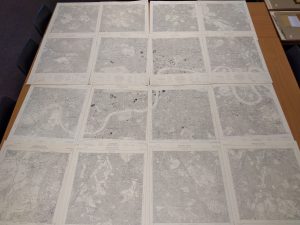
1:10 560 Ordnance Survey map of London (1947-56), sheets TQ27-28, TQ37-38, NW-SE. University of Nottingham School of Geography Map Collection
One of the great attributes of the RGS’s Exhibition Pavilion is its large back wall, over 6m wide and 4m tall, which is visible through the other three glass walls of the pavilion from both the building’s visitor entrance area and from Exhibition Road outside. Our plan for this space was to use a map of London, on which we could illustrate the city’s various sites of interwar internationalism. The first step, then, was to find a map that we had permission to use, would be visually interesting, and ideally would be dated from the interwar period. One potential avenue for this was the University of Nottingham School of Geography map collection, an under-utilised resource in the process of being re-discovered, with a new blog devoted to exploring its riches. The collection did indeed contain several options, including an out-of-copyright and complete 1:10 560 Ordnance Survey map of London, whose 16 sheets dated from between 1947 and 1956 (above). This was wonderfully detailed and would have enabled us to crop it according to our needs. However, it was trumped by a map from a different source, the RGS’s own collection: the ‘Geographia Pictorial Plan of London’, this edition dated 1937 (detail below). Immediately arresting, this map gives a three dimensional impression of the buildings of central London, and what was lost in this close crop (i.e. sites left ‘off the map’ outside central London) was more than compensated by the eye-catching colour and illustration. Intriguingly, the map itself is part of a strongly geographical story: the Geographia cartography company was run by the Hungarian-born Alexander Gross (1879-1958), whose daughter Phyllis Pearsall (1906-1996) was to continue the family cartographical tradition by founding the London A-Z Map.
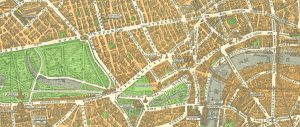
Detail from Pictorial Plan of London. Geographia Ltd., London, 1937 Coronation Edition. Fold-out Map with Card Cover, 46x72cm. RGS-IBG Collections rgsM070601A
The RGS archive was also the source for the materials we included in the Exhibition Pavilion’s display cabinet. The selection of these materials was a collaborative effort between Mike Heffernan, whose 10th December 2018 lecture at the RGS on the Society’s own role in the history of internationalism had drawn on much of this material, and the RGS Deputy Librarian Jan Turner. This cabinet not only introduced a tactile, physical element to an exhibition that otherwise relied on the reproduction of images, but also offered an opportunity for a site-specific intervention that brought the exhibition venue into focus as part of the overall story being told.
Meanwhile, we set to work finalising and writing captions for the images we were to use for the panels and cabinet, and for pull-out examples to adorn the back wall map. We wanted the exhibition to be image-driven, so tried to limit the captions to around 100 words. This again proved a creative exercise, forcing us to think afresh about what exactly each image was conveying. Though challenging at first, this exercise became easier with each successive caption, and it was revelatory to see cross-cutting themes and references emerge (which we were able to convert into internal hyperlinks on the exhibition website).
For the task of transforming our collections of images and texts into a physical exhibition, we collaborated with a design company whose portfolio included past experience producing exhibitions at the RGS. While we had been occasionally chastened by the slowness of the process of clearing copyright and procuring images, conversely our timescales caused friction in the other direction when working with partners used to working fast and intensely to meet an immoveable deadline. Once we had entered the crunch period, the collaboration moved very quickly, with design ideas exchanged across a series of iterative proofs. We were in agreement on the importance of negative space in the design to retain a sense of visual clarity, with colour introduced at the top of the panels to make clear the grouping of front-facing and behind-the-scenes panels; these colours were taken directly from the back-wall map.
Installation & translation to the web
Having existed on a computer screen thus far, it was genuinely exciting to see our materials reproduced at full sized on the printed panels and vinyls. The benefits of working with a professional partner were abundantly clear at this point, and the wallpaper-like installation of the back-wall map (below) had a particularly transformative effect on the room. The panels were quickly erected, and then carefully positioned and angled according to sightlines, light-lines and walking routes. Two vinyl posters were put up to advertise the exhibition to passers-by on Exhibition Road.
- Exhibition panels wait to be erected
- Installing the back-wall map graphic
- Vinyl transfer on Exhibition Road balustrade advertising the exhibition
- Front gate poster advertising the exhibition
After carefully installing the back-board and contents of the cabinet, two elements of the exhibition remained. First, installation of a large plasma screen, on which we played a looping selection of out-of-copyright video clips, illustrating many of the figures, events and themes of the exhibition. And second, the setting up of a table (below) on which to set handouts of various articles by the project team relating to the exhibition themes, our guestbook for visitors to records their thoughts and reactions to the exhibition, and postcards advertising our exhibition website. These were positioned so as to attract the attention of visitors as they made their way toward the exit.
While the exhibition website was made live as the physical exhibition opened, it took another month or so of work to finish it. This website had been envisioned as both an overflow for the resources that did not fit onto the panels, including links to relevant external resources, and as a legacy project that would preserve the exhibition for those who could not make or had missed the physical exhibition. However, the process of writing extended captions and translating the panels into webpages took longer than anticipated to finalise, especially as we took a breather over the Christmas holidays. The consequence of this was the latter aim took precedence, and we began thinking of it not as an exhibition website, but as a virtual exhibition in its own right.
Just as it had been important that the physical exhibition was free to enter, so we made sure to limit the external links in the virtual exhibition to freely accessible sources, whether they be videos, websites or online journalism. Again, the challenge of avoiding the kind of library-bound, paywall-hidden sources so familiar to academic references proved a creative spur that encouraged us to chase different lines of thought, and occasionally resulted in the happy discovery of articles and resources, especially videos, that we would not otherwise – or at least had not previously – come across. The final website, spacesofinternationalism.omeka.net, is thus as much a resource as it is a record, and our hope is that its status as a digital preservation of a physical exhibition does not impede its potential to stand alone and reach new audiences.
Reception
Though the exhibition website does contain feedback forms for each image hosted, the best record we have of how visitors responded to the exhibition is the guestbook. Of course, discussion of this record should be prefaced with the caveat that it only captures the views of those who were able and willing to write them down for us. Nevertheless, these entries make for interesting reading (anonymised in the excerpts that follow).
Some chimed happily with our aims, complimenting the exhibition as ‘wonderfully refreshing’ for its inclusion of ‘multiple perspectives’ and ‘Much unusual materiel … – and you avoided any picture of Churchill!’ Many mentioned that they were, as one visitor put it, ‘Especially pleased to see the attention to men and women behind the scenes, whose stories are now shared’. To quote another contributor at greater length,
‘A very revealing and interesting approach to this topic. After all those who prepare the minutes, documentation and organisation can have a great deal of influence on outcomes. While it may be a ‘liberal’ concept whatever this means I would have thought that international relations and ultimately togetherness must be fundamental in an afflicted and shrinking world. Some of the figures may now be mocked for their ‘failings’ but at least they tried!’
Many comments alluded to the present political situation, in a manner that was certainly more direct than our captions and introduction, if still fairly vague. Typical comments ran along the lines of ‘Many thanks – VERY timely!’, ‘Very interesting and so relevant to the world today’, or ‘An exhibit apropos for the times’. Occasionally they were more specific, perhaps responding to Jake Hodder’s article on “Remaking Internationalism” that we had left as a handout. One visitor wrote that the exhibition was ‘Especially important given the threat to internationalism posed by Brexit, Orban et al’, and another asked: ‘can we learn the lessons of that period to get our own back on track?’
Occasionally, the present political situation became an overbearing intrusion, diverting and polarising visitors’ reactions in ways that completely escaped our intentions. At the milder end, this took the form of pointed comments, like one visitor’s note that ‘obviously we need some more internationalism today’. At other times, it threatened to take over the pages of the guestbook. One visitor took the exhibition as an attack on nationalism:
‘My relatives died in the war for England. Not for the world to come here & force thier [sic] backward cultures on us! Nationalism is not Fascism it is love of country. Proud Brexiteer’
This comment sparked an indignant reply further down the page:
‘A fascinating lecture on the aftermath of the first WW. The previous comment is incorrect – your relatives died (& fought) in a world war, not a British war! Thank god for outward looking, open-minded internationalism, as opposed to narrow minded, inward looking nationalism!’
Since our object had been to complicate our ideas of internationalism, it is tempting to be dispirited by this flattening of the message into a binary view of internationalism as the antithesis of nationalism. However, such responses characterise a slim minority of visitors. The larger conclusion to be drawn is that the circumstances in which such an exhibition takes place cannot help but loom large in how it is interpreted. To talk about internationalism in these charged times is naturally to provoke a response. While it is encouraging to read reactions that chime with one’s intentions, the frequent mentions of the politics of the present also offer their own form of encouragement: that historical research retains an intimate link to the present, a charge that continues to be felt. While much academic work can feel insulated from these currents, our exhibition work has at successive turns felt energised by this connection.
No comments yet, fill out a comment to be the first

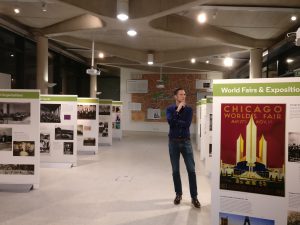
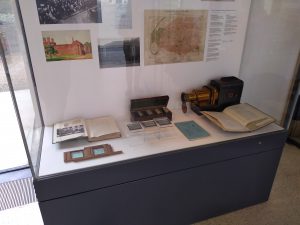
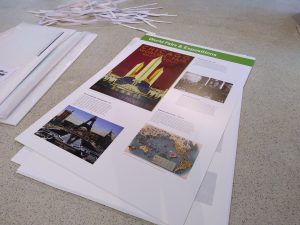
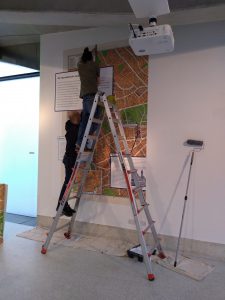
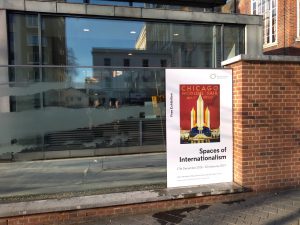
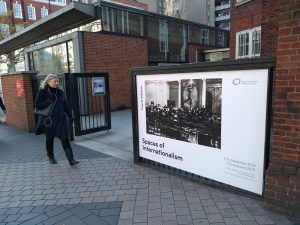
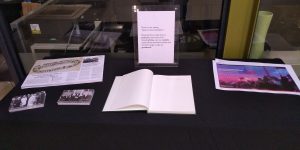
Leave a Reply